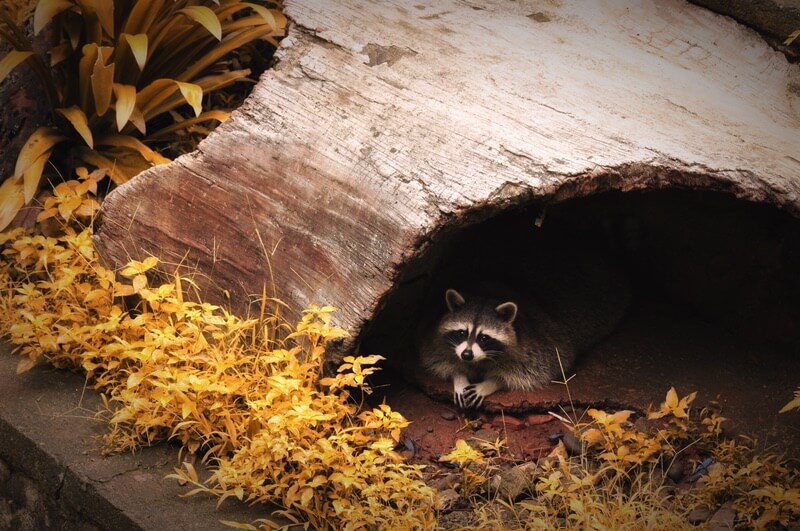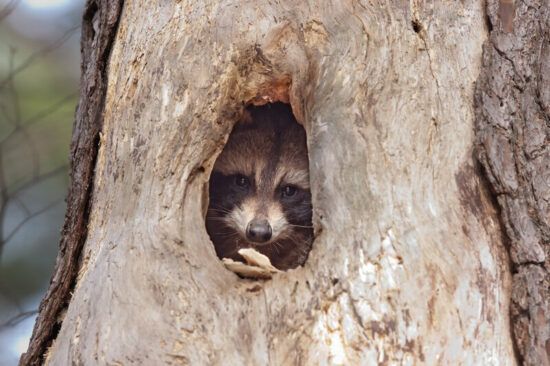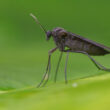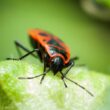Everyone knows about raccoons, but not many are familiar with their nests. This results in poor management of raccoons on their property that aren’t ideal for both them and the animal.
This guide will cover what raccoon nests look like, where you can find them, and what to do if you find one.
Table of Contents
What Does A Raccoon Nest Look Like?
Raccoon nests tend to have a lot of variety to them. These night bandits are busy animals, so they don’t spend much time creating nests from the ground up. We’ll get into how these animals build nests in a bit, but let’s talk about how you can spot a raccoon nest.
Generally, raccoon nests look like a large squirrel nest. Raccoons build their dens a little simpler, but they have a similar shape and mass.
Obviously, raccoon nests are usually a bit larger thanks to the heftier size and weight of these animals. Raccoons also prefer to use materials like hay and long grasses over the twigs and leaves that squirrels use.
All that said, raccoons are highly opportunistic. They prefer to look for suitable nesting areas rather than focus time building one from the ground up. If they do that, it’s usually with whatever materials they find in the area.
Grasses and hay are the preferred materials, but raccoons will take what they can get!
Usually, you’ll find raccoon nests near water and relatively forested areas. These mammals coexist with humans in urban areas, too. However, they like to stay out of sight and blend in with nature when they can.
Expert Tip: Being near water is the most important thing. When not foraging through your garbage cans for food scraps, raccoons will find food to eat in rivers, ponds, and streams. Plus, staying near water keeps them hydrated and healthy.
Where Do Raccoons Nest?
Raccoons are one of the most adaptable animals to live near humans. While they thrive best in rural areas covered in trees and nature, they have no problem living in urban and suburban areas. Next to squirrels and birds, raccoons are one of the more likely animals you’ll encounter in your backyard.
But even still, these masked creatures are pretty elusive. They’re nocturnal, choosing to spend their days resting in their dens before heading out to forage for food when the sun goes down.
So where do raccoons nest?
Raccoons are flexible and will take advantage of any spot they deem safe. Here are a few common raccoon nesting spots.
1. Abandoned Animal Burrows
Here’s the thing about raccoons, they are both intelligent and lazy. These animals like to take the easy way out. That’s why you find them eating your trash rather than hunting prey for food!
They’re the embodiment of opportunism, and there’s no better example than looking at where they like to nest. Many raccoons will gravitate towards abandoned burrows made by foxes or gophers. While raccoons have claws on their paws, they’re not keen on digging holes themselves.
Those claws are primarily used to dig for insects. If you spot an underground raccoon nest, it likely started its life as a den for another animal. Males are inclined to choose subterranean nesting spots, but females can partake too if the space is big enough for kits.
Like all nesting locations, raccoons will go out of their way to choose a burrow that’s in a prime location. It has to be near water, provide ample coverage from predators, and be cozy enough to let them rest uninterrupted. Those “perfect spots” are near forests and wooded areas in most cases.
Of course, raccoons don’t just use abandoned burrows without doing some light remodeling. Most will use hay and grasses to insulate the holes to meet their unique needs.
2. Natural Cavities
Sometimes, mother nature creates the perfect raccoon nest that doesn’t require much work in order for them to utilize it. Once again, it’s about working smarter and not harder for these animals!
Natural cavities occur frequently, and the availability depends entirely on where the raccoon lives.
In swampy areas or heavily forested locations, raccoons look for fallen trees or rock crevices. Rock crevices and small caves offer the most protection. Those hardened minerals are tough even for voracious predators, so they’re the go-to for a raccoon looking to stay in an area for a while.
Meanwhile, tree crevices are well-camouflaged. Raccoons tend to encounter these nesting spots below fallen trees. The wood creates natural protection while keeping them safe from the elements.
Like before, raccoons will gather grasses, twigs, and even leaves to insulate the space and make it perfect for daytime resting.
3. Hollow Trees & Bird Nests
Another place you might see a raccoon nest is in a tree hollow. Make no mistake: These animals are skilled climbers. While they can tip the scales at 20 pounds or more, raccoons have no problem scaling trees and other structures.

In their quest to find shelter, raccoons may come across tree holes that are large enough to accommodate them. These shelters are more prevalent in prairie-like landscapes, but they can occur naturally in any place with trees.
Tree hollows are like ready-made shelters. They don’t need a ton of modification, and they’re perfect for protection. The high elevation keeps raccoons out of harm’s way against would-be predators on the ground.
Believe it or not, raccoons have no shame in using abandoned bird nests, too. If they stumble across an old nest from a large owl or hawk, these animals will not hesitate to use them!
Bird nests are on the smaller side, so only single raccoons usually use them. But once again, the high elevation keeps the animal safe and minimizes disturbances as they rest during the day.
4. Urban Sheds
If you have a shed or another similar backyard structure, don’t be surprised if it eventually becomes home to a raccoon or two. Sheds are a perfect place for raccoon nests in suburban areas.
Natural nesting spots are limited, so these animals often turn to human-made structures. Sheds check off all the boxes. They’re warm, secure, and relatively quiet.
Unlike your home, you likely don’t use your shed every day. So, it’s easy for raccoons to stay out of sight.
Not only that, but your shed is likely full of items that the animals can destroy for insulation. For example, it’s probably a treasure trove of cardboard boxes, old rags, and other random things that raccoons will find helpful.
For this reason, sheds are favorites for raccoon mothers looking for a safe spot to raise their young.
If raccoons don’t use the inside of your shed for their nest, they can also use the space underneath it. Alternatively, they might pick a spot behind it or in items you have leaning against the shed walls.
5. Residential Attics & Chimneys
Hear some faint scurrying in your home at night? It could be that a curious raccoon set up shop right in your own house!
Raccoons don’t just use their climbing skills to scale trees. They can also climb up your exterior walls or chimney. Once on the roof, it’s pretty easy to gain entry into your home.
Chimneys offer a pretty secure nesting spot. You probably don’t use it every day if you’re like most people, so the chimney is just there waiting for an animal to call it home!
But what about attics? Raccoons use their dexterous hands and claws to pry open weak points and squeeze their way through. Whether that’s a fascia board or a loose eave overhang, it’s no match for the agile hands of a raccoon.
As you can imagine, attic spaces are some of the best nesting spots for raccoons. They’re even better than sheds because they’re far away from predators. Pair that with your attic’s generally dark nature, and it’s a prime sleeping space away from the sun and disturbances.
It’s not uncommon for female raccoons to choose attics for having kits. They stay with the young during the day before going and foraging for food at night.
6. Underneath Porches & Decks
Decks and porches are other great spots that raccoons will take advantage of when looking for a nesting area. They’re the next best things to an attic. While not as secure, decks and porches have their perks.
Generally, these areas are closer to garbage cans, food sources, and water. Furthermore, they’re pretty easy to get into without much work. In most cases, raccoons can pry some lattice or protective boards out of the way to crawl inside.
Or, it could be as easy as squeezing under stairs! The worst-case scenario is that they have to do some light digging, but that work is well worth it to be close to food.
The only downside is the potential for regular disturbances. If it’s a porch your family uses often, the raccoon will hear it. They may even cross your path if you go outside in the evening. That’s why it’s important to get rid of raccoons under your deck if you find any.
Decks and porches have another notable perk. Many lead to crawl spaces underneath the house. Crawlspaces are massive and offer greater security.
Furthermore, the area below your house is subject to residual heat from inside. As a result, it’s a toasty spot that raccoons can use to stay warm during the winter months.
7. Leaf Piles & Brush
Lastly, there are leaf piles and natural brush.
These nesting areas are typically the last resort for raccoons when it comes to establishing a nest. They’re not the most comfortable and offer very little security from potential predators. Not only that, but the animal has to put in some work to make leaf piles and brush inhabitable.
As you probably know by now, raccoons prefer to take what’s already available and do as little work as possible.
Generally, this simple form of shelter is temporary. It’s a way to get some quick rest and hunker down for a day or two. But most raccoons will move on to something better.
How Do They Make Nests?
As mentioned earlier, raccoons prefer not to make nests from scratch if they can help it. Most will look for suitable existing spots before building one from scratch.
It’s far easier to move into an abandoned burrow or find a cozy little spot in an attic than it is to gather materials. Raccoons would much rather spend their time foraging for food and conserving energy. They’ll make modifications to caves and dens if necessary, but the less work they have to do, the better!
If they must make a nest, raccoons will put their agile hands to good use. While they have no opposable thumb, raccoons have five fingers that are perfect for moving material! They’ll typically gather look material, shred it up, and use the small pieces to line the nesting area.
Usually, grasses and hays are the go-to. However, raccoons will use anything available. They’ll grab twigs, leaves, pine needles, old newspapers, cardboard, and more.
Once they tear up the material of choice, they use it as insulation. The goal is to prevent heat from escaping the nest while keeping rain and other environmental factors out. Raccoon-made nests don’t offer much in terms of physical protection, but the natural materials can keep the animals hidden from would-be predators.
Is It Dangerous To Approach A Raccoon Nest?
You should never approach a raccoon nest. These animals seem harmless enough, and they’re usually more scared of you than you are of them. But that’s not what you have to worry about.
Raccoons can carry all kinds of diseases. They are known carriers of rabies, and the condition can lead to unpredictable behavior. Rabid raccoons will exhibit aggression at every turn, lashing out at anyone who infringes on the nest. It takes just a bite or scratch to transmit rabies to humans, so it’s not worth the risk!
In addition to rabies, raccoons can carry parasites, bacteria, and a host of other nasty hitchhikers. Even encountering their poop has its risks!
On top of all that, there’s the issue of approaching nesting raccoon babies.
Raccoons will mate between January and June. During that time, males will impregnate multiple females and leave them. Females usually give birth to a litter of kits between March and April.
Unlike other wild animals, raccoons are protective of their young. Mothers can turn pretty nasty if they have a small group of babies they’re trying to protect.
To keep yourself safe, it’s best to avoid approaching raccoon nests. Even if you think you can handle the situation, you should always avoid disturbing the animal.
What Should You Do If You Find A Raccoon Nest?
Just because it’s not wise to disturb raccoons yourself doesn’t mean you have to live with these animals on your property. Raccoons are filthy creatures that could make you and your family very sick. It’s important to address the situation and evict your unwelcome guests as soon as possible.
But how do you do that?
Usually, the best course of action is to call a professional. Pest control experts deal with raccoon nests all the time, and they have the means to remove these animals safely. They’re also well-versed in local laws.
Raccoons aren’t endangered animals, but many jurisdictions have laws to protect them. Attempting to eradicate a raccoon on your own isn’t just dangerous, but it could lead to some hefty fines if you’re not careful.
Laws require pest control experts to use catch and release techniques in most states and local municipalities. The goal is to relocate the animal to a safer spot without causing it any harm. It’s a tricky process, but the pros have the necessary tools and traps to get it done!
Experts will usually bait the raccoons with cat food, tuna, and other tasty treats the animal can’t resist. Once they enter the trap, the door will close, and the raccoon won’t be able to escape.
At that point, pest control will take them to a more rural area where they won’t be a nuisance.
After the raccoon is removed, make sure to have a professional look into the nest for babies. Babies can’t survive independently, and it’s best to relocate them with their mothers.
Also, tear down any raccoon nests once they’re no longer occupied. The last thing you want is another raccoon moving in!
Speaking of prevention, you need to take steps to avoid another potential raccoon situation. If one raccoon makes its way onto your property, there’s a good chance others will follow in subsequent nesting seasons.
Take precautions to make your property as unappealing to these pests as possible. That means locking up bins to prevent them from snacking on your trash, installing raccoon-proof fences, and eliminating all water sources. Take in pet food and dump out any water that accumulates after rain.
If there’s nothing for the raccoons to get in your yard, they’ll likely avoid it.
Look around your property for potential nesting spots and do what you can to make them insecure. You can hire a contractor to close up any weak spots on your home’s roofline, install a spark arrestor to keep animals out of the chimney, and barricade any access points to the deck or crawl space.
Those small tasks go a long way.
For that extra push of security, consider getting some motion detection gear. Motion-activated lights and sprinklers will scare these animals off before they get a chance to find a place to hunker down and nest.
Conclusion
Now that you know where raccoons nest and what their nests look like, you should be able to handle these animals a whole lot easier.
Let us know if you have any questions that we didn’t address above, and we’ll gladly help you out!


